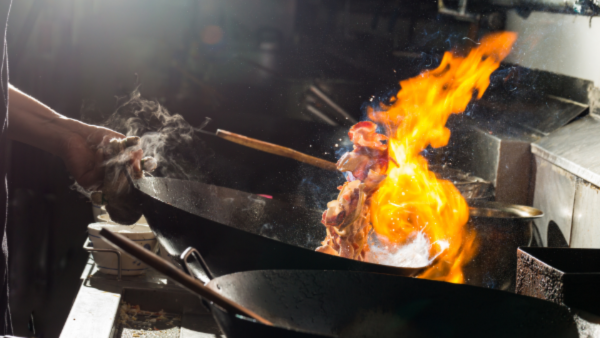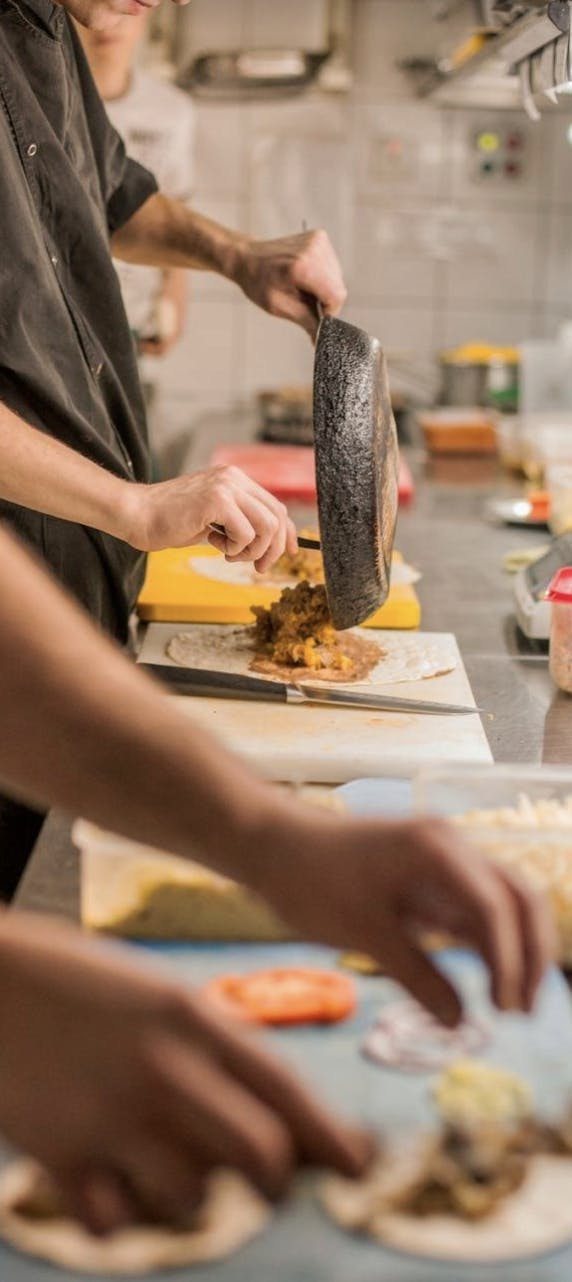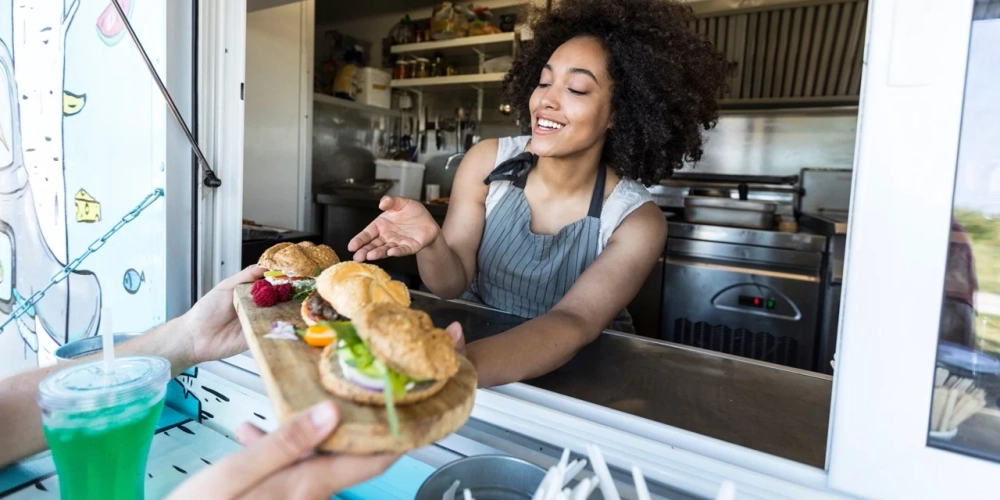Ghost Kitchen or Virtual Kitchen: How to Choose the Right Model for Your Business
Table of Contents
CloudKitchens
How many tacos can be delivered from a 1000sqft restaurant?
The same amount as a 200sqft ghost kitchen.

Even if you’re a seasoned professional within the restaurant industry, the terms “ghost kitchen” and “virtual kitchen” might not yet be part of your vernacular. While some may use them interchangeably, these phrases refer to two distinct business models.
While both offer digitally rendered takeout options for their guests, ghost kitchens typically don’t operate from a traditional restaurant location at all. Virtual kitchens, on the other hand, are an extension of an existing store-front eatery that uses its own kitchen to create a delivery-only menu that may be separate from the one they offer to dine-in customers.
Check out the main benefits of each model now!
Virtual Kitchen vs. Ghost Kitchen: What Are the Benefits of Each?
Before you start cooking up a new strategy for your restaurant, let’s put these two models under the microscope. Below, we’ll walk you through the pros and cons of a ghost kitchen vs. a virtual kitchen to help you make the most informed decision for the future of your food.
| Kitchen Types | Pros | Cons |
|---|---|---|
| Ghost Kitchens | – Low operating costs – Restaurant brand recognition – Increased flexibility | – Absence of physical locations to build brand and draw walk-in sales – Spend more money and time on digital/social branding |
| Virtual Kitchens | – Testing new menu items – Adjusting menu items for a larger delivery radius – Tapping into new sales channels | – Overhead costs – Staffing challenge |
Pros and cons of ghost kitchens
Ghost kitchens are designed for off-premises consumption—and off-premises consumption only. In this model, you won’t find any of the traditional in-person dining equipment, such as:
- Servers, hosts, or other front-of-house staff members
- Cocktail lounges
- Dining tables and chairs
- Carefully selected decor
Instead, their primary focus is on cooking for online food delivery app services such as Grubhub, Uber Eats, or DoorDash. Depending on the third party that the ghost kitchen collaborates with, this location could also be a hub for multiple ghost kitchens—all functioning in the same building.
Some benefits of running a ghost kitchen include:
- Low operating costs: With a much smaller staff and fewer costs associated with a heavily trafficked physical location, ghost kitchens could save on operating costs compared to physical and virtual restaurants.
- Restaurant brand recognition: If you’re a smaller, independent enterprise, testing the local waters with a ghost kitchen could help you run a low-cost operation while you work to build your image and establish brand recognition within your zip code.
- Increased flexibility: Because your brand only exists online, you can feel free to experiment with your brand’s identity without the heavy lifting associated with physical rebranding.
While the benefits of a ghost kitchen certainly abound, you’ll need to account for the most obvious drawback: the absence of a physical location. Without an inviting window display or tantalizing aromas to beckon local diners your way, you’ll have to find other ways of getting the word out on the digital street. Do this by:
- Establishing a strong social media presence
- Encouraging satisfied customers to leave positive reviews on delivery service apps
- Offering discounts or freebies to first-time diners
If you’ve still got a few qualms about the viability of a ghost kitchen, you may want to consider a hybridized alternative: virtual kitchens.
Pros and cons of a virtual kitchen
Virtual kitchens may appear the same as ghost kitchens to a user perusing the varied dishes of a delivery app. The major difference is that virtual kitchens typically piggyback off of brick-and-mortar restaurants that are already in existence. Thus, by nature, virtual restaurants still require full front-of-house staff, kitchen staff, and an ideal physical location to pick up walk-in traffic.
Additionally, there are a couple of different types of virtual kitchens:
- Some virtual kitchens function as an extension of the already-existing restaurant and offer delivery-only options that may differ from the physical location’s menu in terms of price or ingredient availability.
- Other virtual restaurants could function with an entirely different name or menu while using the physical restaurant’s staff and resources.
Wondering how to start a virtual restaurant? Here are some benefits of running a virtual restaurant:
- Testing new menu items: A virtual kitchen could be a clever way to test-drive a potential new menu addition in real time since online ordering menus offer increased flexibility. Making a quick edit to a digital menu is much simpler—and cheaper—than printing out a handful of trial menus and distributing them as hard copies.
- Adjusting menu items for a larger delivery radius: Your business might already be brimming with delivery orders in your nearby area. However, a virtual kitchen would enable you to adjust your menu with items that travel well and have larger profit margins, allowing you to further expand your delivery radius.
- Tapping into new sales channels: A virtual kitchen gives you the opportunity to double down on existing resources while creating a new sales channel. This is especially true if you’re creating a new menu under a different name.
- Despite offering considerable advantages, virtual restaurateurs should keep the following in mind:
- Overhead costs: While virtual kitchens certainly have the potential to increase profit margins, they’re also bound to higher overhead costs including insurance, utilities, and salaries needed to maintain a larger team.
- Staffing: Building a full team is no simple task—servers, bussers, and hosts tend to come and go with the seasons. Unlike ghost kitchens, virtual kitchen owners may find themselves spending less time curating their dishes and more time hunting for the employees needed to prepare them.
Now that you’ve got a clearer picture of the differences between each kitchen model, let’s explore which option could be the most beneficial to you.

Virtual kitchen vs ghost kitchen: Which to choose?
As a chef, restaurant owner, or food entrepreneur, choosing between a virtual restaurant or a ghost kitchen can be a head-scratching decision. While there isn’t a one-size solution that’ll work for every business, there are a few ways to help you narrow down your choice.
1. Consider what resources you have at your disposal
For some, the majority of this decision can be distilled down to a simple question: What do you already have and what do you need?
If you’re an independent entity without a current physical location, you’ve got a couple of options:
- Make use of a ghost kitchen offered by a third party
- Partner your brand as a virtual kitchen to an already existing physical space
Furthermore, if you’re in the early stages of your restaurant business, a ghost kitchen may be the option for you. A ghost kitchen operation would provide you with the opportunity to:
- Set up your business and space quickly
- Start with a small staff (or just yourself)
- Minimize overhead costs
- Experiment with menu items until you’ve established what works for your brand identity
2. Factor in delivery workflow for maximum profitability
Another factor to consider is the logistical cost of operating your business in conjunction with popular food delivery platforms such as Grubhub, Uber Eats, or DoorDash.
With a ghost kitchen, you might have to juggle multiple different platforms and workflows while keeping track of what you’re making, what you’re putting on or taking off the menu, and what you’ve already sent out.
This is where choosing the right ghost kitchen space is essential.
At CloudKitchens, we offer you the space and equipment needed to run your ghost kitchen efficiently. We’ve preempted the logistical nightmare that is food delivery workflow and offer specialized software that streamlines all your delivery platforms into one place.
CloudKitchens software is designed to:
- Put all your delivery platforms on one screen, eliminating the need for multiple tablets
- Manage your business with insights on sales and order volumes
- Mark items on or off the menu in one go
- Track your couriers as they deliver your orders
3. Ensure flexibility for an ever-changing world
When COVID-19 swept our planet in 2019, it completely changed the restaurant and dining world. Many long-standing restaurants couldn’t cope with the loss of indoor dining and had to shutter their doors once and for all.
Other restaurants doubled down on take-out and delivery and were able to skate by until indoor dining was an option again. By that point, many had strengthened their delivery operation enough for it to be a strong permanent sales channel for the business as a whole.
The pandemic taught us the valuable nature of flexibility in a restaurant’s business model. In order for your business to weather whatever storm comes your way, consider the following:
- Ghost kitchens allow your business to operate no matter the circumstances—without worrying as much about spikes in staffing needs or sudden layoffs.
- Whether takeout trends fade over time or are here to stay, virtual kitchen owners can rest easy knowing that their bases will likely be covered in either scenario.
Ghost kitchen vs virtual kitchen: The final verdict
When deciding whether to root your operation in a ghost kitchen or a virtual kitchen, it’s not only important to understand the differences between the two. You’ll also need to take into account your own goals and resources as a restaurant owner.
A virtual kitchen may be perfect for you if you are:
- An already-established restaurant with a physical space
- A food brand ready to franchise itself to other restaurants
- Equipped with the resources to open a brick-and-mortar restaurant that also offers delivery
A ghost kitchen may be the better option if you are:
- An independent chef
- A newly formed brand that needs the flexibility to explore what makes you unique
- A restaurateur who wants to put their vision to the test without the pressure of committing to a physical space
This is where CloudKitchens comes in.

Start cooking with CloudKitchens
CloudKitchens provides the space, tools, and resources necessary for you to succeed in your operation. We’ll help you grow your business and be your technical support system as you navigate your way through the restaurant landscape. With a variety of locations from Sacramento to ghost kitchens in Orlando, there are several choices to expand your business.
Explore ghost kitchen locations across the US:
- Ghost kitchens in San Francisco
- Ghost kitchens in LA
- Ghost kitchens in NYC
- Ghost Kitchens in Toronto
- Ghost Kitchens in Atlanta
- Ghost Kitchens in Dallas
- Ghost Kitchens in Chicago
- Ghost Kitchens in Denver
- Ghost Kitchens in Miami
| DISCLAIMER: This information is provided for general informational purposes only and the content does not constitute an endorsement. CloudKitchens does not warrant the accuracy or completeness of any information, text, images/graphics, links, or other content contained within the blog content. We recommend that you consult with financial, legal, and business professionals for advice specific to your situation. |
Read more:
- Sales vs Business Development: Which One to Pursue for Ghost Kitchens?
- What are Ghost Kitchens? The definitive guide to Virtual Restaurants
- How Much Does It Cost to Start a Restaurant Business?
- How Much Does It Cost to Start a Ghost Kitchen: A Complete Guide
Sources:
Jeffrey Miller. What’s a Ghost Kitchen? A Food Industry Expert Explains. https://theconversation.com/whats-a-ghost-kitchen-a-food-industry-expert-explains-163151
Ghost Kitchen vs. Virtual Kitchen: What’s the Difference?
Exploring ghost kitchens and virtual kitchens? Uncover essential differences to guide your decision. Curious about the details? Explore the in-depth comparison now!
Ghost Kitchen vs. Virtual Kitchen: What’s the Difference?
Exploring ghost kitchens and virtual kitchens? Uncover essential differences to guide your decision. Curious about the details? Explore the in-depth comparison now!
Restaurant365. How a Virtual Kitchen Could Improve Your Restaurant Group’s Profitability. https://www.restaurant365.com/resources/how-a-virtual-kitchen-could-improve-your-restaurant-groups-profitability/
Terrence Doyle. What’s It Like Working In a Ghost Kitchen? https://www.eater.com/22632677/ghost-kitchens-restaurant-industry-food-delivery-takeout
The Local Culinary. About Us. https://www.thelocalculinary.com/about-us
More insights & stories
There’s more where that came from.
Get in the know and check out our additional insights


